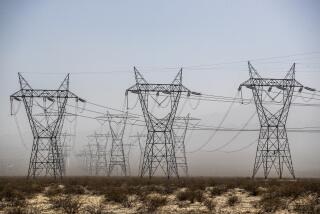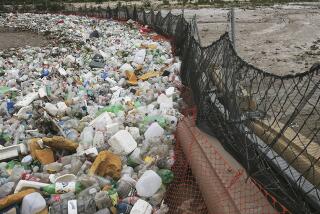Sempra Plans Major Energy Project in Baja
- Share via
MEXICO CITY — Sempra Energy will announce today a $400-million partnership with CMS Energy Corp. to build the Pacific coast’s first liquid natural gas terminal. The project, in Baja California about 60 miles from the U.S.-Mexico border, is designed to address the region’s acute energy shortage.
The project highlights Mexico’s increasing importance to California as a source for energy. At its peak, the new liquid natural gas plant will provide enough gas to fuel 4.5 million homes. It will send gas directly to the California market as well as fuel three major electricity generating stations in Baja that are or soon will be exporting electrons over the international border.
Although several global energy players have said they were interested in constructing a Baja LNG terminal to access the California energy market, Sempra and CMS are the first to commit to a specific site and to give project details, including cost and timeline. The partners say the project might be operational in 2005.
The project still has no permit from the Mexican federal government, and it could face intense opposition from Baja residents and environmentalists. A Sempra Arizona-to-Baja gas pipeline that would be crucial to the terminal also lacks final approval.
The partners promise the project is a clean one that will pose minimal environmental risks.
Sempra is the San Diego-based parent company of San Diego Gas & Electric and Southern California Gas. CMS Energy of Dearborn, Mich., is a global natural gas and electric power company.
The developers are confident that a hungry market will militate in its favor. A principal reason for California’s electricity crisis of the last year was a drastic shortage of natural gas, especially in the western United States. Low prices in the late 1990s discouraged gas exploration companies from drilling, and supplies dwindled.
Shortages could be similarly acute in Mexico, especially in Baja California, in coming years as the nation shifts away from fuel oil to natural gas. Mexico is believed to have vast natural gas deposits but lacks the capital to develop them. Significant shortages are forecast by 2004.
Two power plants fueled by natural gas, one developed by Sempra, the other by InterGen of Boston, are under construction in Mexicali, 125 miles east of San Diego in Baja California. Both were built with the idea of selling excess electricity to California.
As proposed, the LNG project would give the region access to natural gas produced and liquefied throughout the Pacific Rim, leaving it less susceptible to North American shortages. The partners say they expect to buy gas from producers in Australia, Malaysia and Indonesia.
Once built, the terminal would accept supercooled liquid natural gas delivered by ship to the Baja facility, store it, then re-gasify and send it north as market conditions dictate.
Although Mexico has never issued a license for a liquid natural gas terminal, Energy Secretary Ernesto Martens has publicly encouraged construction. He said earlier this year that Baja could be the site of two such plants. Officials have been enthusiastic about an El Paso Energy Partners LNG terminal planned in Tamaulipas state on the Gulf of Mexico.
The Sempra-CMS project would produce as much as 1 billion cubic feet of gas a day and then send it toward the Baja power plants and beyond via a 40-mile pipeline. Power plants each consume around 80 million cubic feet of gas a day, so the new facility would have the capacity to fuel 12 such facilities.
An industry rule of thumb is that gas prices have to be at least $3 per thousand square feet to be profitable. Near-term gas futures, which have dropped dramatically in recent weeks from as much as $8 earlier this year, closed Thursday at $2.41.
The project site is an unpopulated, rocky area totaling 300 acres about 12 miles north of Ensenada. The project will include a ship loading dock jutting 1,000 feet or more into the Pacific Ocean, two to four giant storage tanks measuring 140,000 cubic meters each and a gasification plant.
The project’s cost, which could go as high as $500 million, stems from the expense of building the ship-docking facility and the storage facilities, which will hold gas cooled at temperatures as low as 260 degrees below zero.
The site is not far from weekend-home sites in Baja favored by many Californians. Some opponents see LNG plants as a safety risk as well as an environmental hazard because of the possibility of the storage facilities’ exploding if the cooling systems fail.
“We will comply with all the rules and regulations of Mexico and take all the mitigation measures,” said Sempra executive George Liparidis. “We will address any and all concerns, and we will have an environmentally acceptable project.”
Other energy companies, including El Paso Energy, BP, Royal Dutch Shell and Chevron Corp. have expressed interest in building liquid natural gas terminals on the Pacific coast of North America but have not announced specific projects.
Sempra’s other Latin American investments, apart from the 215-mile Baja Norte Pipeline and the Mexicali Power plant, include natural gas distribution systems in Mexicali and other Mexican cities. CMS Energy owns power plants totaling 2,000 megawatts of electric capacity in Latin America, in addition to major gas pipeline projects in Argentina and Chile.
More to Read
Sign up for Essential California
The most important California stories and recommendations in your inbox every morning.
You may occasionally receive promotional content from the Los Angeles Times.










